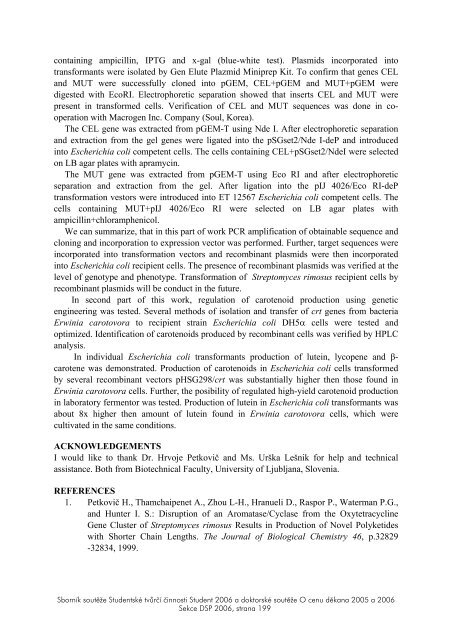production of selected secondary metabolites in transformed ...
production of selected secondary metabolites in transformed ...
production of selected secondary metabolites in transformed ...
Create successful ePaper yourself
Turn your PDF publications into a flip-book with our unique Google optimized e-Paper software.
conta<strong>in</strong><strong>in</strong>g ampicill<strong>in</strong>, IPTG and x-gal (blue-white test). Plasmids <strong>in</strong>corporated <strong>in</strong>to<br />
transformants were isolated by Gen Elute Plazmid M<strong>in</strong>iprep Kit. To confirm that genes CEL<br />
and MUT were successfully cloned <strong>in</strong>to pGEM, CEL+pGEM and MUT+pGEM were<br />
digested with EcoRI. Electrophoretic separation showed that <strong>in</strong>serts CEL and MUT were<br />
present <strong>in</strong> <strong>transformed</strong> cells. Verification <strong>of</strong> CEL and MUT sequences was done <strong>in</strong> cooperation<br />
with Macrogen Inc. Company (Soul, Korea).<br />
The CEL gene was extracted from pGEM-T us<strong>in</strong>g Nde I. After electrophoretic separation<br />
and extraction from the gel genes were ligated <strong>in</strong>to the pSGset2/Nde I-deP and <strong>in</strong>troduced<br />
<strong>in</strong>to Escherichia coli competent cells. The cells conta<strong>in</strong><strong>in</strong>g CEL+pSGset2/NdeI were <strong>selected</strong><br />
on LB agar plates with apramyc<strong>in</strong>.<br />
The MUT gene was extracted from pGEM-T us<strong>in</strong>g Eco RI and after electrophoretic<br />
separation and extraction from the gel. After ligation <strong>in</strong>to the pIJ 4026/Eco RI-deP<br />
transformation vestors were <strong>in</strong>troduced <strong>in</strong>to ET 12567 Escherichia coli competent cells. The<br />
cells conta<strong>in</strong><strong>in</strong>g MUT+pIJ 4026/Eco RI were <strong>selected</strong> on LB agar plates with<br />
ampicill<strong>in</strong>+chloramphenicol.<br />
We can summarize, that <strong>in</strong> this part <strong>of</strong> work PCR amplification <strong>of</strong> obta<strong>in</strong>able sequence and<br />
clon<strong>in</strong>g and <strong>in</strong>corporation to expression vector was performed. Further, target sequences were<br />
<strong>in</strong>corporated <strong>in</strong>to transformation vectors and recomb<strong>in</strong>ant plasmids were then <strong>in</strong>corporated<br />
<strong>in</strong>to Escherichia coli recipient cells. The presence <strong>of</strong> recomb<strong>in</strong>ant plasmids was verified at the<br />
level <strong>of</strong> genotype and phenotype. Transformation <strong>of</strong> Streptomyces rimosus recipient cells by<br />
recomb<strong>in</strong>ant plasmids will be conduct <strong>in</strong> the future.<br />
In second part <strong>of</strong> this work, regulation <strong>of</strong> carotenoid <strong>production</strong> us<strong>in</strong>g genetic<br />
eng<strong>in</strong>eer<strong>in</strong>g was tested. Several methods <strong>of</strong> isolation and transfer <strong>of</strong> crt genes from bacteria<br />
Erw<strong>in</strong>ia carotovora to recipient stra<strong>in</strong> Escherichia coli DH5α cells were tested and<br />
optimized. Identification <strong>of</strong> carotenoids produced by recomb<strong>in</strong>ant cells was verified by HPLC<br />
analysis.<br />
In <strong>in</strong>dividual Escherichia coli transformants <strong>production</strong> <strong>of</strong> lute<strong>in</strong>, lycopene and βcarotene<br />
was demonstrated. Production <strong>of</strong> carotenoids <strong>in</strong> Escherichia coli cells <strong>transformed</strong><br />
by several recomb<strong>in</strong>ant vectors pHSG298/crt was substantially higher then those found <strong>in</strong><br />
Erw<strong>in</strong>ia carotovora cells. Further, the posibility <strong>of</strong> regulated high-yield carotenoid <strong>production</strong><br />
<strong>in</strong> laboratory fermentor was tested. Production <strong>of</strong> lute<strong>in</strong> <strong>in</strong> Escherichia coli transformants was<br />
about 8x higher then amount <strong>of</strong> lute<strong>in</strong> found <strong>in</strong> Erw<strong>in</strong>ia carotovora cells, which were<br />
cultivated <strong>in</strong> the same conditions.<br />
ACKNOWLEDGEMENTS<br />
I would like to thank Dr. Hrvoje Petkovič and Ms. Urška Lešnik for help and technical<br />
assistance. Both from Biotechnical Faculty, University <strong>of</strong> Ljubljana, Slovenia.<br />
REFERENCES<br />
1. Petkovič H., Thamchaipenet A., Zhou L-H., Hranueli D., Raspor P., Waterman P.G.,<br />
and Hunter I. S.: Disruption <strong>of</strong> an Aromatase/Cyclase from the Oxytetracycl<strong>in</strong>e<br />
Gene Cluster <strong>of</strong> Streptomyces rimosus Results <strong>in</strong> Production <strong>of</strong> Novel Polyketides<br />
with Shorter Cha<strong>in</strong> Lengths. The Journal <strong>of</strong> Biological Chemistry 46, p.32829<br />
-32834, 1999.<br />
Sborník soutěže Studentské tvůrčí č<strong>in</strong>nosti Student 2006 a doktorské soutěže O cenu děkana 2005 a 2006<br />
Sekce DSP 2006, strana 199
















